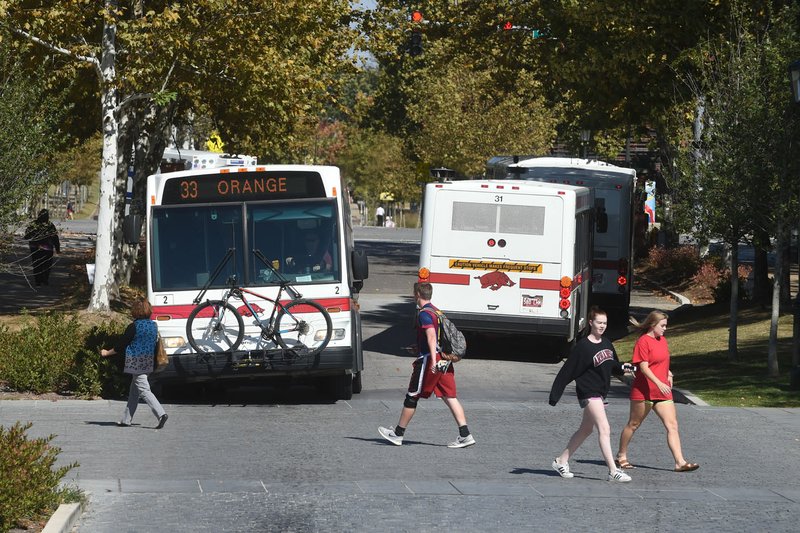FAYETTEVILLE -- The city could get a new Arkansas 112 at a significant discount if it takes that stretch of highway off the state's hands.
The Transportation Committee on Tuesday reviewed a proposal in which the city would own and maintain about 4 miles of Arkansas 112 from 15th Street to Interstate 49. In exchange, the state would widen or improve four sections of the highway at little to no cost to the city.
The city also would take responsibility for about 3 miles of Arkansas 156 from South School Avenue to Pump Station Road, north of Drake Field. The highways would become a city streets and the state would remove both segments from its system.
In 2014, the city got $2.4 million in federal aid to improve Maple Street between Garland Avenue and Razorback Road, all of which is part of Arkansas 112. An extra $3 million was needed to finish the project, but bids raised the cost to more than $4 million, City Engineer Chris Brown said.
The city, University of Arkansas and Arkansas Highway and Transportation Department have worked over the past several years to widen and improve the highway through and near campus. The university planted trees and installed pedestrian lighting from 15th Street to Wedington Drive while the city did the utility work, amounting to millions of dollars, said Mike Johnson, associate vice chancellor for the university's facilities management.
The three entities met to discuss an arrangement to close the gap. In the first part of the plan, the Highway Department would take the $2.4 million in federal money and pitch in an additional $1.7 million, leaving about $1 million left for the city to cover, according to information from Brown.
The city and the university would split the $1 million cost, Brown said.
Secondly, the Highway Department would finish widening and other improvements to Arkansas 112 north of Poplar Street to Van Asche Drive at no cost to the city, Brown said. The estimated cost for that project is $6.4 million.
Additionally, the Highway Department would either do the asphalt resurfacing or provide money for asphalt resurfacing between Maple and North streets, Brown said. The estimated cost for that is $247,500.
Lastly, the Highway Department would widen Razorback Road to three lanes from Leroy Pond Drive north to the football stadium.
"It is a large investment by the Highway Department on the front end," Brown said. "It is a pretty large responsibility that the city will be taking over on the back end."
All of the widening and resurfacing essentially would amount to Arkansas 112 being in new condition with likely no significant maintenance costs over the next 10 years or longer, Brown said.
Arkansas 165 would be a different story. About $600,000 of resurfacing is needed there, but only certain segments require immediate attention, Brown said. The rest of the cost could be spread over years.
Alderman Matthew Petty, chairman of the Transportation Committee, said he wanted to make sure the city would have design authority over the streets for which it would take responsibility.
"It looks like it's got the bones of a good deal," he said. "My concern is still do we get to decide how the roadways get striped through the U of A without AHTD interference?"
Alderwoman Adella Gray said the proposal would be a huge commitment not to be taken lightly. She also requested input from transportation director Terry Gulley, whose crews would see a huge spike in workload.
Alderman Alan Long questioned why Arkansas 156 was made part of the deal. Petty suggested making that highway a separate issue. Alderman Justin Tennant, the fourth member of the committee, wasn't present at Tuesday's meeting.
In other business, the committee also reviewed preliminary drawings to extend East Sain Street and Van Asche Drive from College Avenue to Joyce Boulevard.
The plan entailed building a bridge across Mud Creek to connect future Sain Street to Vantage Drive and ultimately Joyce Boulevard. It also called for a roundabout connecting Millsap Road to a future street north to the Sain Street extension. A portion of College Avenue also would be raised to connect Sain Street to the flyover.
Steven Beam with engineering firm Burns & McDonnell referred to the project as "Phase II" of the flyover. The Sain Street extension would be a long-term project in the $10-15 million range, while extending Millsap Road with a roundabout would cost somewhere between $3-4 million.
The committee also requested more information regarding which direction traffic flows from the new university parking lot on Razorback Road. The question was whether to open the parking lot to the north for cars to access Hotz Drive.
Neighbors have reported more traffic along Palmer Avenue from cars trying to head north and west from the parking lot. Three streets had to be vacated to build the parking lot, and one of the conditions was Hotz Drive would be closed to the north, Brown said.
City staff did a traffic count on a Friday afternoon and found few cars turning west onto Center Street and north onto Palmer Avenue. The committee asked for more data during more traffic-heavy hours on weekdays.
The committee also approved vacating Jupiter Drive near the Johnson limit for development. The recommendation will go before the City Council when they discuss the issue during their next meeting Tuesday.
NW News on 10/12/2016

